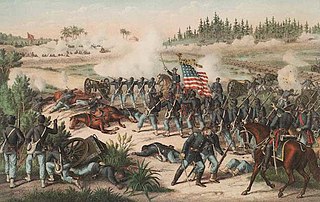
The Battle of Olustee or Battle of Ocean Pond was fought in Baker County, Florida on February 20, 1864, during the American Civil War. It was the largest battle fought in Florida during the war.
The Battle of Cotton Plant also known as Action at Hill's Plantation or Action at Cache River or Action at Round Hill was fought during the American Civil War in Woodruff County, Arkansas. Frustrated in its attempt to march to Little Rock by a lack of supplies, the Union Army of the Southwest under the command of Samuel Ryan Curtis moved south down the White River. Curtis's army encountered a Confederate force led by Albert Rust on the east bank of the Cache River near Cotton Plant. Rust was only able to bring two Texas cavalry regiments into action. These horsemen attacked the Federal advance guard under Charles Edward Hovey, but after a spirited fight, Union reinforcements arrived and drove off the Texans. Rust's force made a disorderly retreat and Curtis's army was able to march south to Clarendon before veering east to occupy Helena on the Mississippi River.
The Battle of Bayou Fourche was fought on September 10, 1863, near Little Rock, Arkansas, and was the final battle of the Little Rock campaign during the American Civil War. A Union force commanded by Major General Frederick Steele had begun an advance from Helena, Arkansas, west towards Little Rock in August. The Union campaign met light resistance aside from the Battle of Bayou Meto, while Confederate troops under Major General Sterling Price built fortifications on the other side of the Arkansas River from Little Rock.
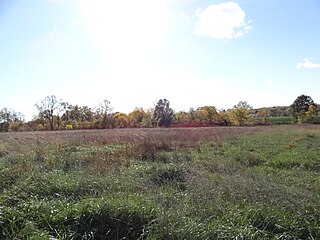
The Battle of Marais des Cygnes took place on October 25, 1864, in Linn County, Kansas, during Price's Missouri Campaign during the American Civil War. It is also known as the Battle of Trading Post. In late 1864, Confederate Major-General Sterling Price invaded the state of Missouri with a cavalry force, attempting to draw Union troops away from the primary theaters of fighting further east. After several victories early in the campaign, Price's Confederate troops were defeated at the Battle of Westport on October 23 near Kansas City, Missouri. The Confederates then withdrew into Kansas, camping along the banks of the Marais des Cygnes River on the night of October 24. Union cavalry pursuers under Brigadier General John B. Sanborn skirmished with Price's rearguard that night, but disengaged without participating in heavy combat.

The Second Battle of Independence was fought on October 22, 1864, near Independence, Missouri, as part of Price's Raid during the American Civil War. In late 1864, Major General Sterling Price of the Confederate States Army led a cavalry force into the state of Missouri, hoping to create a popular uprising against Union control, draw Union Army troops from more important areas, and influence the 1864 United States presidential election.

The Battle of Little Blue River was fought on October 21, 1864, as part of Price's Raid during the American Civil War. Major General Sterling Price of the Confederate States Army led an army into Missouri in September 1864 with hopes of challenging Union control of the state. During the early stages of the campaign, Price abandoned his plan to capture St. Louis and later his secondary target of Jefferson City. The Confederates then began moving westwards, brushing aside Major General James G. Blunt's Union force in the Second Battle of Lexington on October 19. Two days later, Blunt left part of his command under the authority of Colonel Thomas Moonlight to hold the crossing of the Little Blue River, while the rest of his force fell back to Independence. On the morning of October 21, Confederate troops attacked Moonlight's line, and parts of Brigadier General John B. Clark Jr.'s brigade forced their way across the river. A series of attacks and counterattacks ensued, neither side gaining a significant advantage.
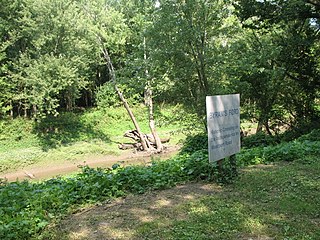
The Battle of Byram's Ford was fought on October 22 and 23, 1864, in Missouri during Price's Raid, a campaign of the American Civil War. With the Confederate States of America collapsing, Major General Sterling Price of the Confederate States Army conducted an invasion of the state of Missouri in late 1864. Union forces led Price to abandon goals of capturing the cities of St. Louis and Jefferson City, and he turned west with his army towards Kansas City.

The First Battle of Newtonia was fought on September 30, 1862, between Confederate soldiers commanded by Colonel Douglas H. Cooper and a Union column commanded by Brigadier General Frederick Salomon near Newtonia, Missouri, during the American Civil War. Cooper's force had moved into southwestern Missouri, and encamped near the town of Newtonia. The Confederate column was composed mostly of cavalry led by Colonel Joseph O. Shelby and a brigade of Native Americans. A Union force commanded by Brigadier General James G. Blunt moved to intercept Cooper's force. Blunt's advance force, led by Salomon, reached the vicinity of Newtonia on September 29, and attacked Cooper's position on September 30. A Union probing force commanded by Colonel Edward Lynde was driven out of Newtonia by Cooper's forces on the morning of the 30th.
The Battle of Poison Spring was fought in Ouachita County, Arkansas on April 18, 1864, as part of the Camden Expedition, during the American Civil War. A Union force commanded by Major General Frederick Steele had moved from Little Rock, Arkansas towards Shreveport, Louisiana in support of Major-General Nathaniel Banks' move up the Red River towards Shreveport. After Banks was defeated at the battles of Mansfield and Pleasant Hill, Steele was isolated in Arkansas. Short on supplies, Steele sent a detachment commanded by Colonel James M. Williams to search for supplies. Williams' column was attacked by Confederate troops under the command of Brigadiers General John S. Marmaduke and Samuel B. Maxey. After a sharp fight, Williams' command was routed, losing its wagon train and four cannons. The defeat at Poison Spring and another defeat at the Battle of Marks' Mills a week later led Steele to retreat to Little Rock. The battle is infamous for the Confederates' slaughter and mutilation of African-American Union soldiers of the 1st Kansas Colored Infantry. Poison Springs Battleground State Park, which is part of the Camden Expedition Sites National Historic Landmark, preserves a portion of the site of the battle.
The Battle of Prairie D'Ane, also known as the Skirmish at Prairie D'Ane, Battle of Gum Springs, or Battle of Moscow, was fought in present-day Nevada County, Arkansas, as part of the Camden Expedition, during the American Civil War. The Camden Expedition was launched by Union forces as part of the Red River Campaign of 1864. U.S. planners envisioned two federal armies converging simultaneously, one force under the command of Maj. Gen. Nathaniel Banks pressing northward up the Red River commencing at Alexandria, Louisiana and the other federal army under the command of Maj. Gen. Frederick Steele driving southwestward from Little Rock, Arkansas. The objective was to press the rebel army of Gen. E. Kirby Smith back upon the rebel stronghold at Shreveport and defeat him. If successful, a somewhat vague second phase envisioned the two federal armies combining into one large force and continuing their offensive with a westward push into Texas.
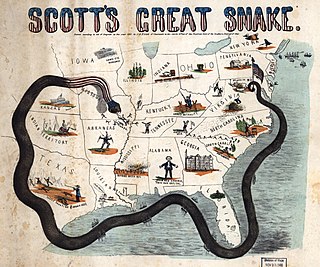
The lower seaboard theater of the American Civil War encompassed major military and naval operations that occurred near the coastal areas of the Southeastern United States: in Alabama, Florida, Louisiana, Mississippi, South Carolina, and Texas) as well as southern part of the Mississippi River.
The Battle of Griswoldville was the first battle of Sherman's March to the Sea, fought November 22, 1864, during the American Civil War. A Union Army brigade under Brig. Gen. Charles C. Walcutt fought three brigades of Georgia militia under Brig. Gen. Pleasant J. Philips, at Griswoldville, near Macon, Georgia, and continued its march toward Savannah.

Florida participated in the American Civil War as a member of the Confederate States of America. It had been admitted to the United States as a slave state in 1845. In January 1861, Florida became the third Southern state to secede from the Union after the November 1860 presidential election victory of Abraham Lincoln. It was one of the initial seven slave states which formed the Confederacy on February 8, 1861, in advance of the American Civil War.
USS Columbine was a side-wheel steamer that patrolled with the South Atlantic Blockading Squadron of the United States Navy in the American Civil War.
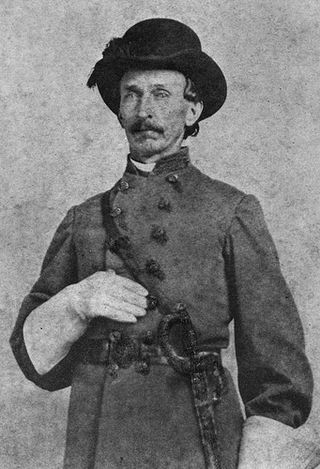
John Jackson Dickison, known as J. J. Dickison, was an officer in the Confederate States Army during the American Civil War. Dickison is mostly remembered as being the person who led the attack which resulted in the capture of the Union warship USS Columbine in the "Battle of Horse Landing". This was one of the few instances in which a Union warship was captured by land-based Confederate forces during the Civil War and the only known incident in U.S. history where a cavalry unit sank an enemy gunboat. Dickison and his men were victorious in all of his raids against the Union troops in Florida, including his raid in Gainesville what is known as the Battle of Gainesville. Tragedy struck Dickison, when one of his sons, both of whom served under his command, was killed during a raid.

The Skirmish at Cedar Creek, also known as Camp Mooney or McGirt's Creek, was a small engagement of the American Civil War fought in present-day Jacksonville, Florida on March 1, 1864. It was fought between a small Confederate States Army outpost and the 40th Massachusetts Volunteer Infantry of the Union Army, and resulted in 35 casualties. It was the last engagement in the Olustee Campaign.
The 40th Regiment, Massachusetts Volunteer Infantry Regiment was a three-year infantry regiment of the Union Army that served in the Department of Virginia and North Carolina, the Army of the Potomac, and the Department of the South during the American Civil War.
Harris's Missouri Battery was an artillery battery that served in the Confederate States Army during the American Civil War. The battery was organized in early 1864 when the 13th Missouri Light Battery was reorganized in a process that may not have been officially approved; Captain Samuel Stanhope Harris commanded the new unit. The battery fought in the Camden Expedition in early 1864, seeing action in the Battle of Prairie D'Ane and the Battle of Poison Spring in April. In June, the battery was present at the Battle of Ditch Bayou. Harris's Battery accompanied Sterling Price during his raid into Missouri in late 1864, during which it fought at the battles of Pilot Knob, Glasgow, Little Blue River, Big Blue River, and Mine Creek, as well as several smaller skirmishes. At Mine Creek, the battery's cannons were captured. On May 26, 1865, the battery surrendered; the men of the battery were paroled.

The 1st Missouri Field Battery was a field artillery battery that served in the Confederate States Army during the American Civil War. The battery was formed by Captain Westley F. Roberts in Arkansas in September 1862 as Roberts' Missouri Battery and was originally armed with two 12-pounder James rifles and two 6-pounder smoothbore guns. The unit fought in the Battle of Prairie Grove on December 7, as part of a Confederate offensive. Roberts' Battery withdrew after the battle and transferred to Little Rock, Arkansas, where Roberts resigned and was replaced by Lieutenant Samuel T. Ruffner.
The 10th Texas Field Battery was an artillery battery that served in the Confederate States Army during the American Civil War. After being formed in early 1861 by Benjamin H. Pratt, the battery served with a cavalry formation led by Colonel William Henry Parsons for part of 1862. It was called upon to enter Missouri in support of troop movements related to the Battle of Prairie Grove, but this did not occur. It then operated along the Mississippi River in early 1863, harassing enemy shipping. The unit then participated in Marmaduke's Second Expedition into Missouri and the Battle of Pine Bluff in 1863. Late in 1864, the battery, now under the command of H. C. Hynson, served in Price's Raid, participating in several battles and skirmishes, including the disastrous Battle of Mine Creek. One source claims the unit's service ended on May 26, 1865, while a Confederate report dated June 1, 1865, states that it existed but did not have cannons. Confederate forces in the Trans-Mississippi Department surrendered on June 2.











